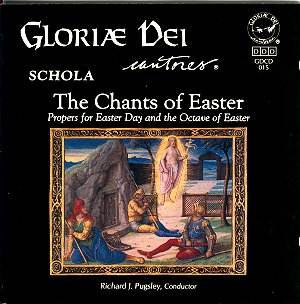This disc contains the Propers of the Mass for Easter
Day and the Octave of Easter, 31 items in all on a disc lasting over
73 minutes. It is quite tricky holding such a programme of short items
together with nothing to bind it together. I did wonder whether performing
fewer items, but binding them together with the Ordinary of the Mass
would have made for more coherent programming.
The CD booklet informs us that '"The foundation of
their interpretation in this recording is three-fold: the rhythmic marks
of the Laon MS (Biblothèque municipale, 239) according to the
studies of Dom Eugène Cardine; the implications of modality;
and the corporate experience of using the chant for daily worship since
1976." Regrettably they do not expand on this rather gnomic statement,
which leaves the average listener unenlightened about what, if any,
differences there are between the singing of the Schola and contemporary
practice in performing chant. (In fact Dom Eugène Cardine and
the Solesmes school have emphasised the natural word rhythm as the basis
for chant rather than purely metrical approach.) This is the only real
musical substance in the booklet; it does not provide any information
about the musical background to the chant. The booklet includes texts
and translations for all the pieces, but what background there is here
is a religious one. This is very admirable, but surely the booklet's
editors should have considered their wider audience. It is fascinating
to know that the Easter Day Feast is one of only two Feasts of the Church
calendar with roots in the very earliest levels of Christian worship,
but couldn't we have been given some information about how this, musically,
affects the chants that are sung?
As far as the style of singing the plainchant goes,
it is done pretty much in the way that I was taught and there are no
real surprises. The Introits are all sung without the 'Gloria Patri'
whereas the Communion sentences have all acquired Psalm sentences and
'Gloria Patri'. This is foreign to my (rather limited) experience and
receives no comment in the booklet.
The Propers for Easter Day are shared out between a
men's choir and a women's choir, except for the lovely Sequence, 'Victimae
paschali', which is sung alternim with both groups singing the final
verse - the only time on the disc that the women and men sing together.
Henceforward the individual days are sung alternately by the women's
or the men's choir. This is gives a welcome variety to the texture and
presumably reflects their practice in services (the booklet does not
say). But surely we could have had some items sung by both groups. These
performances are not a slavish reconstruction of early performance practice,
so there is no reason for both groups not to sing together. A number
of members of the group take turns performing the role of cantor. This
is an admirably democratic policy, but means that in some sections the
solo voice is rather weaker than is ideal for the complex music involved.
Gloriae Dei Cantores are a Massachusetts-located choir
numbering around forty, with female altos. They are a church-based,
non-professional choir, singing weekly services. The Gloriae Dei Cantores
Schola is a 16-person group dedicated to singing Gregorian Chant. They
have been singing plainchant regularly since 1976, both the daily Benedictine
Monastic Offices and the Ordinary and Proper of the Mass. They sing
in an admirably flexible manner with beautiful diction. They have rather
a habit of shading off the ends of phrases in rather an extreme manner,
which can become a little annoying after a while. But, just how unanimous
should chant be, especially on a recording? Here, both the men and the
women exhibit small lapses in unanimity which causes the line to lack
the firmness that it needs. In performance, or recorded in a more generous
and forgiving acoustic, this would not matter. But here, on a disc that
is fairly closely recorded, every little lapse is noticeable.
But in the end, we come back to the format of the disc.
By the last track, no matter how admirably sung, I would have liked
a little variety. Surely we would have appreciated the Propers more
if fewer of them had been recorded and they had been offset by parts
of the Ordinary of the Mass and some chanted Lessons. After all, this
is how this music is supposed to be appreciated. After listening to
this recording you rather feel like you have eaten too many truffles,
a surfeit of good things.
Robert Hugill

